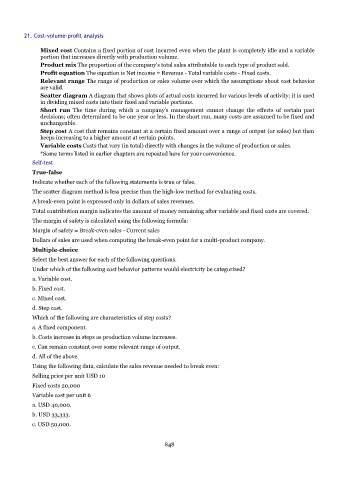Page 847 - Accounting Principles (A Business Perspective)
P. 847
21. Cost-volume-profit analysis
Mixed cost Contains a fixed portion of cost incurred even when the plant is completely idle and a variable
portion that increases directly with production volume.
Product mix The proportion of the company's total sales attributable to each type of product sold.
Profit equation The equation is Net income = Revenue - Total variable costs - Fixed costs.
Relevant range The range of production or sales volume over which the assumptions about cost behavior
are valid.
Scatter diagram A diagram that shows plots of actual costs incurred for various levels of activity; it is used
in dividing mixed costs into their fixed and variable portions.
Short run The time during which a company's management cannot change the effects of certain past
decisions; often determined to be one year or less. In the short run, many costs are assumed to be fixed and
unchangeable.
Step cost A cost that remains constant at a certain fixed amount over a range of output (or sales) but then
keeps increasing to a higher amount at certain points.
Variable costs Costs that vary (in total) directly with changes in the volume of production or sales.
*Some terms listed in earlier chapters are repeated here for your convenience.
Self-test
True-false
Indicate whether each of the following statements is true or false.
The scatter diagram method is less precise than the high-low method for evaluating costs.
A break-even point is expressed only in dollars of sales revenues.
Total contribution margin indicates the amount of money remaining after variable and fixed costs are covered.
The margin of safety is calculated using the following formula:
Margin of safety = Break-even sales - Current sales
Dollars of sales are used when computing the break-even point for a multi-product company.
Multiple-choice
Select the best answer for each of the following questions.
Under which of the following cost behavior patterns would electricity be categorized?
a. Variable cost.
b. Fixed cost.
c. Mixed cost.
d. Step cost.
Which of the following are characteristics of step costs?
a. A fixed component.
b. Costs increase in steps as production volume increases.
c. Can remain constant over some relevant range of output.
d. All of the above.
Using the following data, calculate the sales revenue needed to break even:
Selling price per unit USD 10
Fixed costs 20,000
Variable cost per unit 6
a. USD 40,000.
b. USD 33,333.
c. USD 50,000.
848

